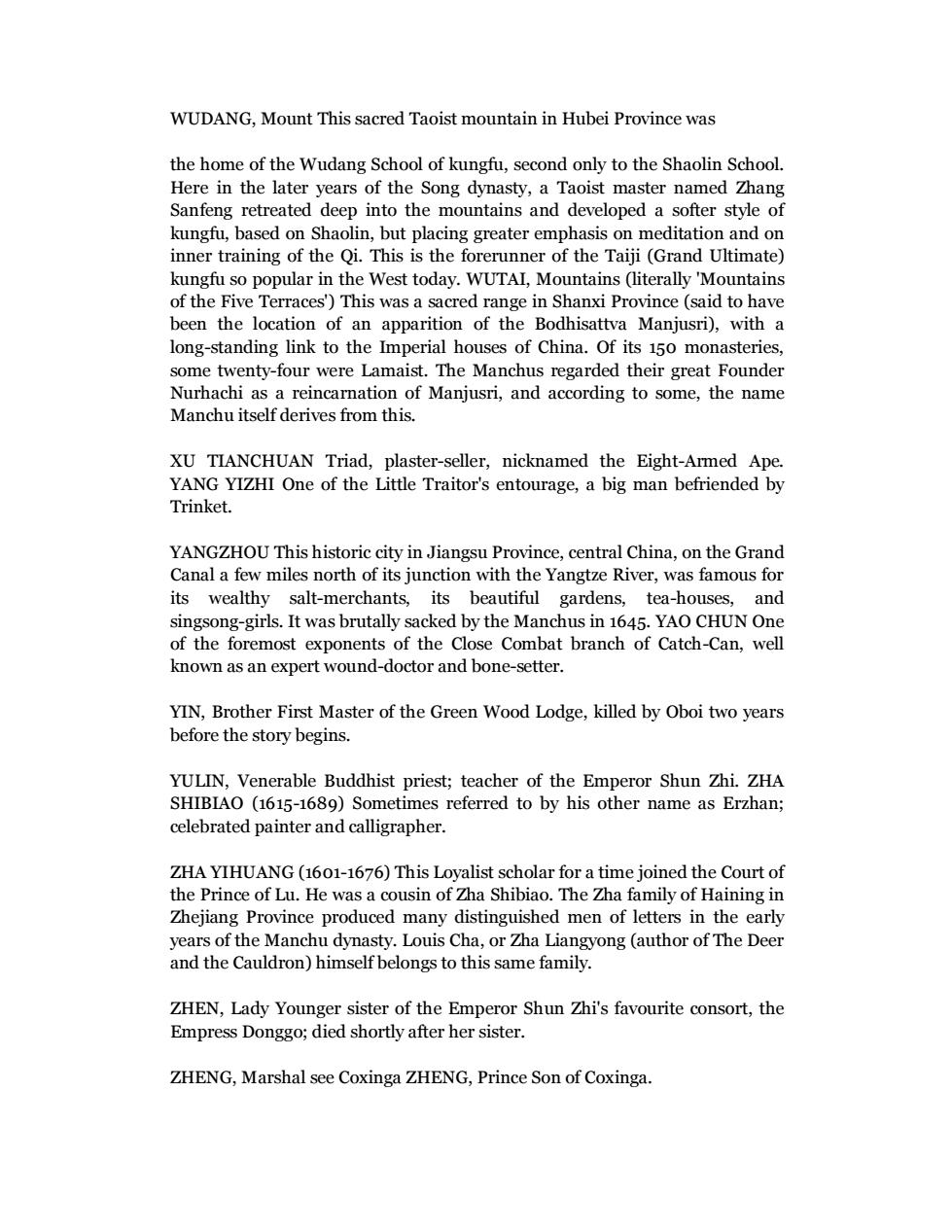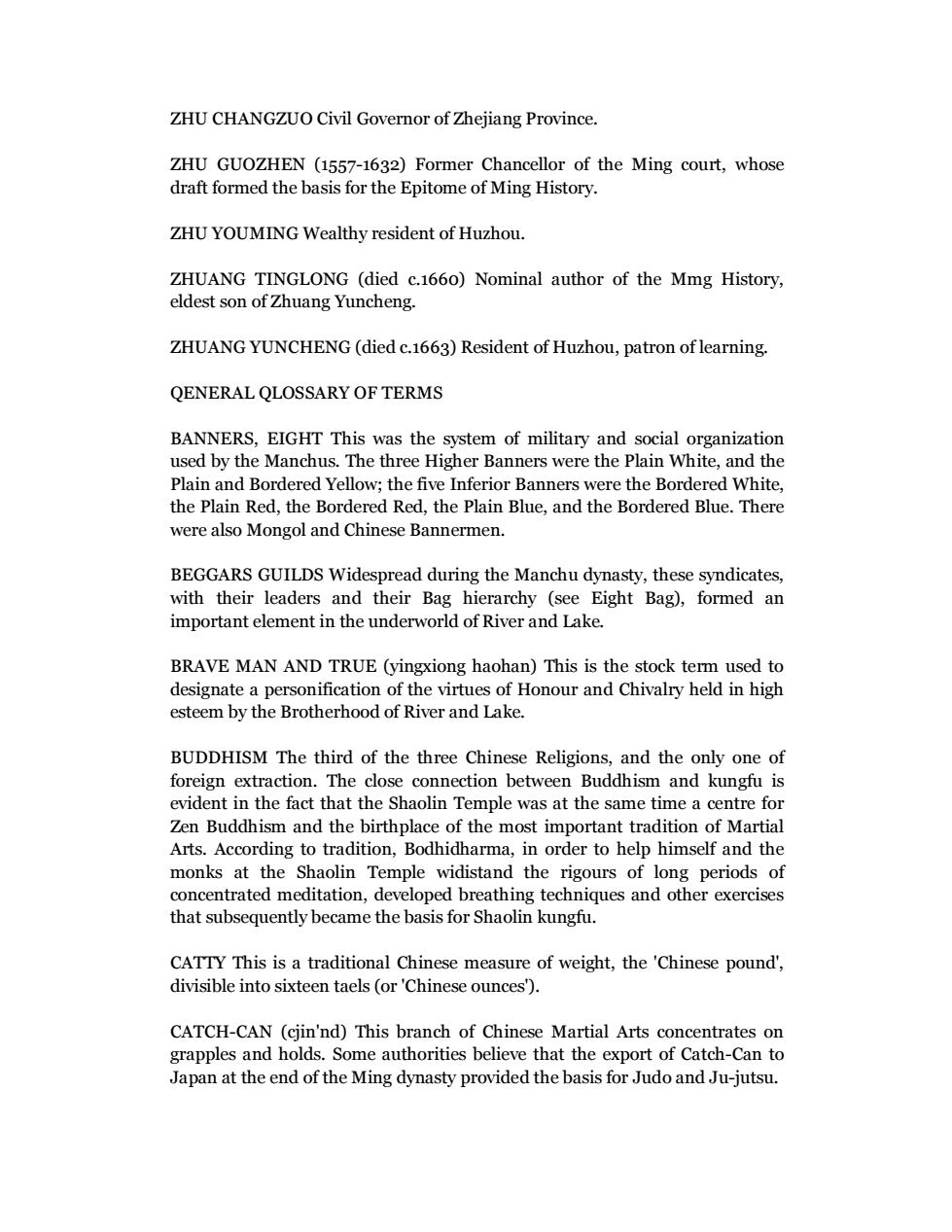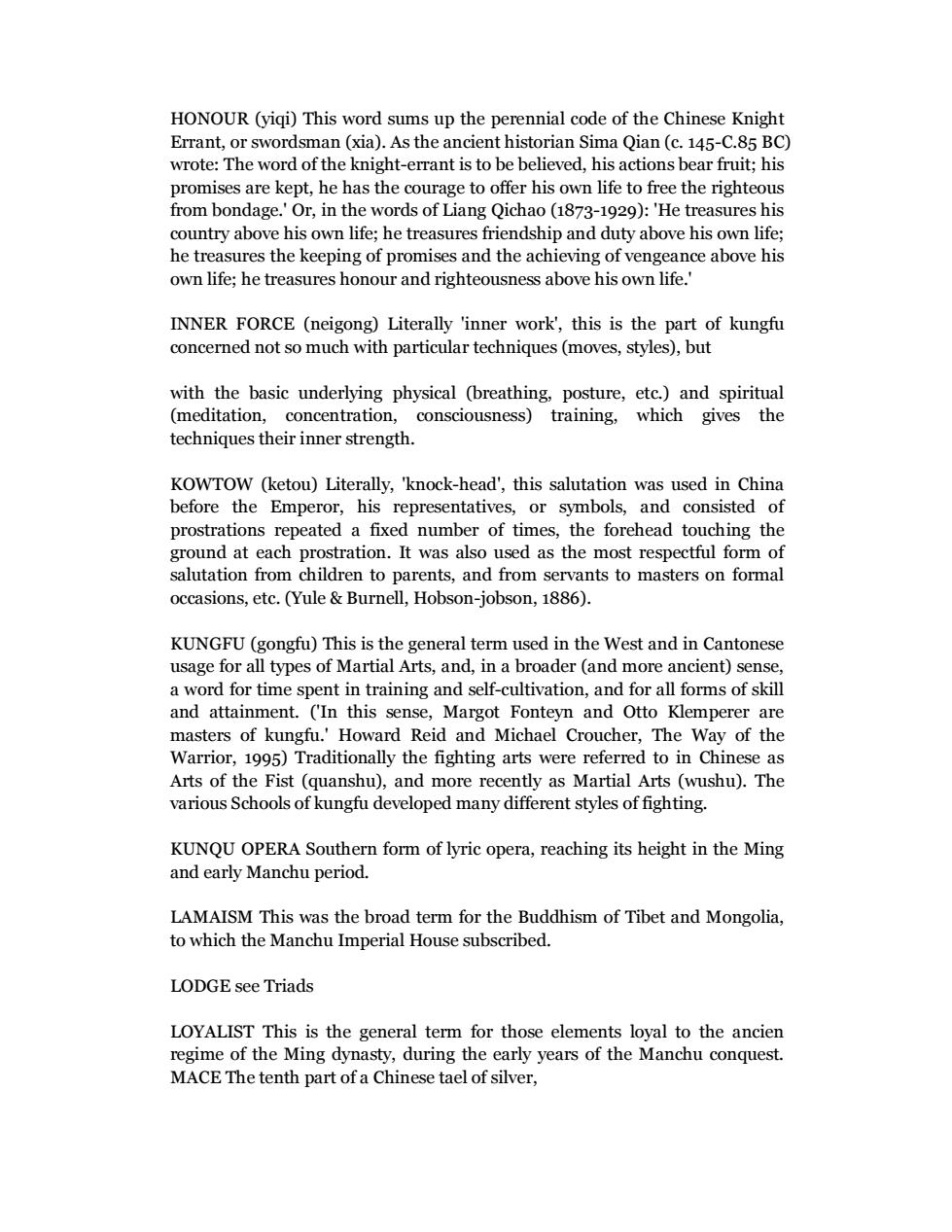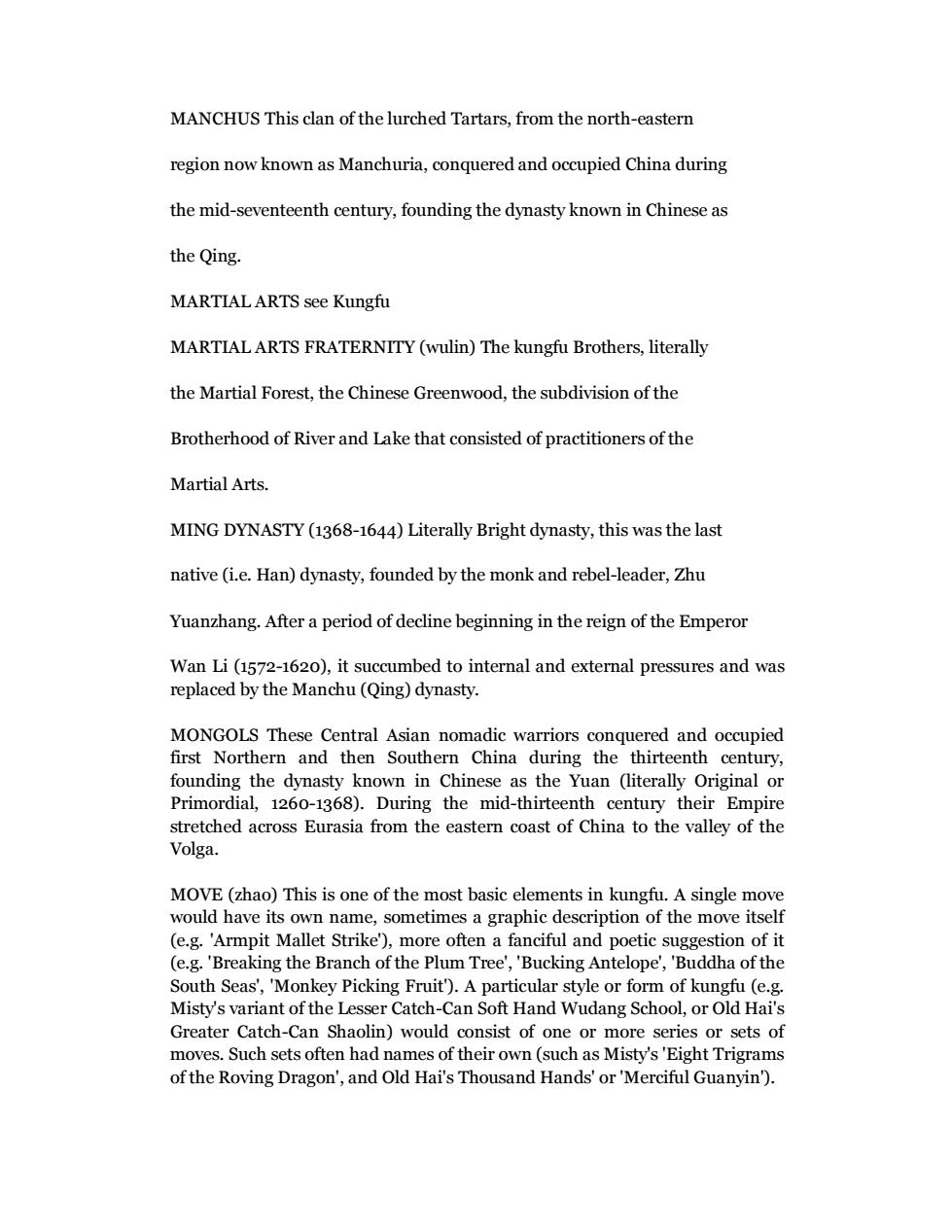
WUDANG, Mount This sacred Taoist mountain in Hubei Province wasthe home of the Wudang School of kungfu, second only to the Shaolin School.Here in the later years of the Song dynasty, a Taoist master named ZhangSanfeng retreated deep into the mountains and developed a softer style ofkungfu, based on Shaolin, but placing greater emphasis on meditation and oninner training of the Qi. This is the forerunner of the Taiji (Grand Ultimate)kungfu so popular in the West today. WUTAI, Mountains (literally'Mountainsof the Five Terraces') This was a sacred range in Shanxi Province (said to havebeen thelocation of an apparition of the Bodhisattva Manjusri),with along-standing link to the Imperial houses of China. Of its 15o monasteries,some twenty-four were Lamaist. The Manchus regarded their great FounderNurhachi as a reincarnation of Manjusri, and according to some, the nameManchu itself derives from this.XU TIANCHUAN Triad, plaster-seller, nicknamed the Eight-Armed Ape.YANG YIZHI One of the Little Traitor's entourage, a big man befriended byTrinket.YANGZHOU This historic city in Jiangsu Province, central China, on the GrandCanal a few miles north of its junction with the Yangtze River, was famous foritswealthy salt-merchants,itsbeautiful gardens,tea-houses,andsingsong-girls. It was brutally sacked by the Manchus in 1645. YAO CHUN Oneof the foremost exponents of the Close Combat branch of Catch-Can, wellknown as an expertwound-doctor and bone-setter.YIN,Brother First Master of the Green Wood Lodge, killed by Oboi two yearsbeforethe storybegins.YULIN, Venerable Buddhist priest; teacher of the Emperor Shun Zhi. ZHASHIBIAO (1615-1689) Sometimes referred to by his other name as Erzhan;celebrated painter and calligrapher.ZHA YIHUANG (16o1-1676)This Loyalist scholarfor a time joined the Court ofthePrince of Lu.He was a cousin of Zha Shibiao.TheZha family of Haining inZhejiang Province produced many distinguished men of letters in the earlyyears of the Manchu dynasty. Louis Cha, or Zha Liangyong (author of The DeerandtheCauldron)himselfbelongstothis samefamily.ZHEN, Lady Younger sister of the Emperor Shun Zhi's favourite consort, theEmpress Donggo; died shortly after her sister.ZHENG,Marshalsee CoxingaZHENG,PrinceSonof Coxinga
WUDANG, Mount This sacred Taoist mountain in Hubei Province was the home of the Wudang School of kungfu, second only to the Shaolin School. Here in the later years of the Song dynasty, a Taoist master named Zhang Sanfeng retreated deep into the mountains and developed a softer style of kungfu, based on Shaolin, but placing greater emphasis on meditation and on inner training of the Qi. This is the forerunner of the Taiji (Grand Ultimate) kungfu so popular in the West today. WUTAI, Mountains (literally 'Mountains of the Five Terraces') This was a sacred range in Shanxi Province (said to have been the location of an apparition of the Bodhisattva Manjusri), with a long-standing link to the Imperial houses of China. Of its 150 monasteries, some twenty-four were Lamaist. The Manchus regarded their great Founder Nurhachi as a reincarnation of Manjusri, and according to some, the name Manchu itself derives from this. XU TIANCHUAN Triad, plaster-seller, nicknamed the Eight-Armed Ape. YANG YIZHI One of the Little Traitor's entourage, a big man befriended by Trinket. YANGZHOU This historic city in Jiangsu Province, central China, on the Grand Canal a few miles north of its junction with the Yangtze River, was famous for its wealthy salt-merchants, its beautiful gardens, tea-houses, and singsong-girls. It was brutally sacked by the Manchus in 1645. YAO CHUN One of the foremost exponents of the Close Combat branch of Catch-Can, well known as an expert wound-doctor and bone-setter. YIN, Brother First Master of the Green Wood Lodge, killed by Oboi two years before the story begins. YULIN, Venerable Buddhist priest; teacher of the Emperor Shun Zhi. ZHA SHIBIAO (1615-1689) Sometimes referred to by his other name as Erzhan; celebrated painter and calligrapher. ZHA YIHUANG (1601-1676) This Loyalist scholar for a time joined the Court of the Prince of Lu. He was a cousin of Zha Shibiao. The Zha family of Haining in Zhejiang Province produced many distinguished men of letters in the early years of the Manchu dynasty. Louis Cha, or Zha Liangyong (author of The Deer and the Cauldron) himself belongs to this same family. ZHEN, Lady Younger sister of the Emperor Shun Zhi's favourite consort, the Empress Donggo; died shortly after her sister. ZHENG, Marshal see Coxinga ZHENG, Prince Son of Coxinga

ZHU CHANGZUOCivil Governor of Zhejiang Province.ZHU GUOZHEN (1557-1632) Former Chancellor of the Ming court, whosedraftformedthebasisfortheEpitomeof MingHistory.ZHU YOUMING Wealthy resident of Huzhou.ZHUANG TINGLONG (died c.166o)Nominal author of the MmgHistory,eldest sonofZhuangYuncheng.ZHUANGYUNCHENG(diedc.1663)ResidentofHuzhou,patronoflearningQENERALQLOSSARYOFTERMSBANNERS, EIGHT This was the system of military and social organizationused by the Manchus. The three Higher Banners were the Plain White, and thePlain and Bordered Yellow; the five Inferior Banners were the Bordered White,the Plain Red, the Bordered Red, the Plain Blue, and the Bordered Blue. Therewere also Mongol and Chinese Bannermen.BEGGARS GUILDS Widespread during the Manchu dynasty, these syndicates,with their leaders and their Bag hierarchy (see Eight Bag), formed animportantelement in the underworld of River and Lake.BRAVE MAN AND TRUE (yingxiong haohan) This is the stock term used todesignate a personification of the virtues of Honour and Chivalry held in highesteem by the Brotherhood of River and Lake.BUDDHISM The third of the three Chinese Religions, and the only one offoreign extraction.The close connection between Buddhism and kungfu isevident in the fact that the Shaolin Temple was at the same time a centre forZen Buddhism and the birthplace of the most important tradition of MartialArts. According to tradition, Bodhidharma, in order to help himself and themonks at the Shaolin Temple widistand the rigours of long periods ofconcentrated meditation, developed breathing techniques and other exercisesthat subsequentlybecame thebasis for Shaolinkungfu.CATTY This is a traditional Chinese measure of weight, the 'Chinese pound',divisible into sixteen taels (or'Chinese ounces).CATCH-CAN (cjin'nd) This branch of Chinese Martial Arts concentrates ongrapples and holds. Some authorities believe that the export of Catch-Can toJapan at the end of the Ming dynasty provided the basis for Judo and Ju-jutsu
ZHU CHANGZUO Civil Governor of Zhejiang Province. ZHU GUOZHEN (1557-1632) Former Chancellor of the Ming court, whose draft formed the basis for the Epitome of Ming History. ZHU YOUMING Wealthy resident of Huzhou. ZHUANG TINGLONG (died c.1660) Nominal author of the Mmg History, eldest son of Zhuang Yuncheng. ZHUANG YUNCHENG (died c.1663) Resident of Huzhou, patron of learning. QENERAL QLOSSARY OF TERMS BANNERS, EIGHT This was the system of military and social organization used by the Manchus. The three Higher Banners were the Plain White, and the Plain and Bordered Yellow; the five Inferior Banners were the Bordered White, the Plain Red, the Bordered Red, the Plain Blue, and the Bordered Blue. There were also Mongol and Chinese Bannermen. BEGGARS GUILDS Widespread during the Manchu dynasty, these syndicates, with their leaders and their Bag hierarchy (see Eight Bag), formed an important element in the underworld of River and Lake. BRAVE MAN AND TRUE (yingxiong haohan) This is the stock term used to designate a personification of the virtues of Honour and Chivalry held in high esteem by the Brotherhood of River and Lake. BUDDHISM The third of the three Chinese Religions, and the only one of foreign extraction. The close connection between Buddhism and kungfu is evident in the fact that the Shaolin Temple was at the same time a centre for Zen Buddhism and the birthplace of the most important tradition of Martial Arts. According to tradition, Bodhidharma, in order to help himself and the monks at the Shaolin Temple widistand the rigours of long periods of concentrated meditation, developed breathing techniques and other exercises that subsequently became the basis for Shaolin kungfu. CATTY This is a traditional Chinese measure of weight, the 'Chinese pound', divisible into sixteen taels (or 'Chinese ounces'). CATCH-CAN (cjin'nd) This branch of Chinese Martial Arts concentrates on grapples and holds. Some authorities believe that the export of Catch-Can to Japan at the end of the Ming dynasty provided the basis for Judo and Ju-jutsu

CLOSING VITAL POINTS (dianxue, cf. Japanese atemi) This is one of themost specialized branches of Chinese Martial Arts, using pressure on selectedsensitive vital points (the points of the acupuncture system) to immobilize andeven kill an opponent. By means of the same technique, the points can also be'opened', or re-activated.CONFUCIANISM Although not referred to very specifically in The Deer andthe Cauldron,this is the State ideology that pervaded Chinese society from theHan dynasty (second century BC) until the early twentieth century. Basedloosely on the teachings of Confucius (551-479 BC) and his foremost disciplesand successors, this placed social cohesion and loyalty to ancestor, father, andEmperor,aboveall other considerations.Thiswasoften in conflict with the more subversive and consciousness-centred beliefs ofTaoism, Buddhism, and the whole spectrum of'marginal' (i.e.anti-Confucian)thinking, but over the years the Confucian ideologues exhibited a remarkableknack for absorbing and co-opting their own 'opposition'.DIMSUM Cantonese term for a large variety of delicious snack-like dishes.EIGHT BAG Member of the Beggars Guild. The ranks of the beggars guildswere graded according to the number of cloth bags they carried over theirshoulders.The highest rank was a Nine Bag member, who was entitled tospecial privileges at occasions such asweddings.EUNUCHs The Chinese system of court eunuchs (the Japanese scholarTaisuke Mitamura in his classic study calls them 'palace termites') enduredwell over 2,ooo years and through twenty-five dynasties. During the late Mingdynasty,eunuchs (in existence sinceatleast the second centuryAD)dominatedthe Court. Under the first Manchu Emperor Shun Zhi, their number and theirpowers were greatly reduced. Under Emperor Kang Xi there were only 4oo or5oo eunuchs, compared with 10o,o00 in the last years of the Ming dynasty.Castration was performed by a specialist for a fee of six taels, and both thescrotum and the penis were removed. The severed parts, known as the bao or'treasure' (it is interesting to note that Trinket's Chinese name, Xiaobao, meanslittle treasure'), were processed,placed in a container, sealed, and then placedon a high shelf. This had to be shown whenever the eunuch was advanced inrank, and was buried with the owner after his death (eunuchs hoped to berestored tofull masculinityin the next world).FLYING, Art of (qing-gong) This is a semi-legendary type of levitational kungfu,bymeans ofwhich thepractitioner canmovewith extraordinarylightness andrapidity,and without actuallytouchingtheground or leaving anytrace
CLOSING VITAL POINTS (dianxue, c.f. Japanese atemi) This is one of the most specialized branches of Chinese Martial Arts, using pressure on selected sensitive vital points (the points of the acupuncture system) to immobilize and even kill an opponent. By means of the same technique, the points can also be 'opened', or re-activated. CONFUCIANISM Although not referred to very specifically in The Deer and the Cauldron, this is the State ideology that pervaded Chinese society from the Han dynasty (second century BC) until the early twentieth century. Based loosely on the teachings of Confucius (551-479 BC) and his foremost disciples and successors, this placed social cohesion and loyalty to ancestor, father, and Emperor, above all other considerations. This was often in conflict with the more subversive and consciousness-centred beliefs of Taoism, Buddhism, and the whole spectrum of 'marginal' (i.e. anti-Confucian) thinking, but over the years the Confucian ideologues exhibited a remarkable knack for absorbing and co-opting their own 'opposition'. DIMSUM Cantonese term for a large variety of delicious snack-like dishes. EIGHT BAG Member of the Beggars Guild. The ranks of the beggars guilds were graded according to the number of cloth bags they carried over their shoulders. The highest rank was a Nine Bag member, who was entitled to special privileges at occasions such as weddings. EUNUCHS The Chinese system of court eunuchs (the Japanese scholar Taisuke Mitamura in his classic study calls them 'palace termites') endured well over 2,000 years and through twenty-five dynasties. During the late Ming dynasty, eunuchs (in existence since at least the second century AD) dominated the Court. Under the first Manchu Emperor Shun Zhi, their number and their powers were greatly reduced. Under Emperor Kang Xi there were only 400 or 500 eunuchs, compared with 100,000 in the last years of the Ming dynasty. Castration was performed by a specialist for a fee of six taels, and both the scrotum and the penis were removed. The severed parts, known as the bao or 'treasure' (it is interesting to note that Trinket's Chinese name, Xiaobao, means 'little treasure'), were processed, placed in a container, sealed, and then placed on a high shelf. This had to be shown whenever the eunuch was advanced in rank, and was buried with the owner after his death (eunuchs hoped to be restored to full masculinity in the next world). FLYING, Art of (qing-gong) This is a semi-legendary type of levitational kungfu, by means of which the practitioner can move with extraordinary lightness and rapidity, and without actually touching the ground or leaving any trace

HONOUR (yiqi) This word sums up the perennial code of the Chinese KnightErrant, or swordsman (xia). As the ancient historian Sima Qian (c. 145-C.85 BC)wrote: The word of the knight-errant is to be believed, his actions bear fruit; hispromises are kept, he has the courage to offer his own life to free the righteousfrom bondage.'Or, in the words of Liang Qichao (1873-1929):He treasures hiscountry above his own life; he treasures friendship and duty above his own life;he treasures thekeeping of promises and theachieving of vengeance above hisown life; he treasures honour and righteousness above his own life.'INNER FORCE (neigong) Literally'inner work', this is the part of kungfuconcerned not so much with particular techniques (moves, styles), butwith the basic underlying physical (breathing, posture, etc.) and spiritual(meditation,concentration,consciousness)training,whichgives thetechniques their inner strength.KOWTOW (ketou) Literally, 'knock-head', this salutation was used in Chinabefore the Emperor, his representatives, or symbols, and consisted ofprostrations repeated a fixed number of times, the forehead touching theground at each prostration.It was also used as the most respectful form ofsalutation from children to parents, and from servants to masters on formaloccasions,etc.(Yule&Burnell, Hobson-jobson,1886).KUNGFU (gongfu)This is thegeneral termused in the West and in Cantoneseusage for all types of Martial Arts, and, in a broader (and more ancient) sensea word for time spent in training and self-cultivation,and forall forms of skilland attainment. (In this sense, Margot Fonteyn and Otto Klemperer aremasters of kungfu.Howard Reid and Michael Croucher, The Way of theWarrior,1995)Traditionallythe fighting arts were referred to in Chinese asArtsoftheFist(quanshu),and morerecentlyasMartialArts(wushu).Thevarious Schools of kungfu developed many different styles of fighting.KUNQUOPERA Southern form of lyric opera,reaching its height in the Mingand early Manchu period.LAMAISMThis was the broad term for theBuddhism of Tibet and Mongolia,to which the Manchu Imperial House subscribed.LODGEseeTriadsLOYALIST This is the general term for those elements loyal to the ancienregime of the Ming dynasty, during the early years of the Manchu conquest.MACE The tenth part of a Chinese tael of silver
HONOUR (yiqi) This word sums up the perennial code of the Chinese Knight Errant, or swordsman (xia). As the ancient historian Sima Qian (c. 145-C.85 BC) wrote: The word of the knight-errant is to be believed, his actions bear fruit; his promises are kept, he has the courage to offer his own life to free the righteous from bondage.' Or, in the words of Liang Qichao (1873-1929): 'He treasures his country above his own life; he treasures friendship and duty above his own life; he treasures the keeping of promises and the achieving of vengeance above his own life; he treasures honour and righteousness above his own life.' INNER FORCE (neigong) Literally 'inner work', this is the part of kungfu concerned not so much with particular techniques (moves, styles), but with the basic underlying physical (breathing, posture, etc.) and spiritual (meditation, concentration, consciousness) training, which gives the techniques their inner strength. KOWTOW (ketou) Literally, 'knock-head', this salutation was used in China before the Emperor, his representatives, or symbols, and consisted of prostrations repeated a fixed number of times, the forehead touching the ground at each prostration. It was also used as the most respectful form of salutation from children to parents, and from servants to masters on formal occasions, etc. (Yule & Burnell, Hobson-jobson, 1886). KUNGFU (gongfu) This is the general term used in the West and in Cantonese usage for all types of Martial Arts, and, in a broader (and more ancient) sense, a word for time spent in training and self-cultivation, and for all forms of skill and attainment. ('In this sense, Margot Fonteyn and Otto Klemperer are masters of kungfu.' Howard Reid and Michael Croucher, The Way of the Warrior, 1995) Traditionally the fighting arts were referred to in Chinese as Arts of the Fist (quanshu), and more recently as Martial Arts (wushu). The various Schools of kungfu developed many different styles of fighting. KUNQU OPERA Southern form of lyric opera, reaching its height in the Ming and early Manchu period. LAMAISM This was the broad term for the Buddhism of Tibet and Mongolia, to which the Manchu Imperial House subscribed. LODGE see Triads LOYALIST This is the general term for those elements loyal to the ancien regime of the Ming dynasty, during the early years of the Manchu conquest. MACE The tenth part of a Chinese tael of silver

MANCHUS This clan of the lurched Tartars, from the north-easternregion now known as Manchuria, conquered and occupied China duringthe mid-seventeenth century, founding the dynasty known in Chinese asthe Qing.MARTIALARTSseeKungfuMARTIALARTS FRATERNITY (wulin)ThekungfuBrothers, literallythe Martial Forest,the Chinese Greenwood, the subdivision of theBrotherhood of River and Lake that consisted of practitioners of theMartialArts.MING DYNASTY (1368-1644) Literally Bright dynasty, this was the lastnative (i.e.Han) dynasty, founded bythe monk and rebel-leader, ZhuYuanzhang. After a period of decline beginning in the reign of the EmperorWan Li (1572-1620), it succumbed to internal and external pressures and wasreplaced bythe Manchu (Qing)dynasty.MONGOLs These Central Asian nomadic warriors conquered and occupiedfirst Northern and then Southern China during the thirteenth century,founding the dynasty known in Chinese as the Yuan (literally Original orPrimordial,126o-1368).Duringthemid-thirteenthcenturytheirEmpirestretchedacrossEurasiafromtheeastern coastof China tothevalleyoftheVolga.MOvE (zhao) This is one of the most basic elements in kungfu. A single movewould have its own name, sometimes a graphic description of the move itself(e.g.'Armpit Mallet Strike'), more often a fanciful and poetic suggestion of it(e.g.'Breaking the Branch of the Plum Tree','Bucking Antelope','Buddha of theSouth Seas', 'Monkey Picking Fruit'). A particular style or form of kungfu (e.g.Misty's variant of the Lesser Catch-Can Soft Hand Wudang School, or Old Hai'sGreaterCatch-CanShaolin)would consistof oneormoreseriesorsetsofmoves. Such sets often had names of their own (such as Misty's'Eight Trigramsof the Roving Dragon', and Old Hai's Thousand Hands' or 'Merciful Guanyin')
MANCHUS This clan of the lurched Tartars, from the north-eastern region now known as Manchuria, conquered and occupied China during the mid-seventeenth century, founding the dynasty known in Chinese as the Qing. MARTIAL ARTS see Kungfu MARTIAL ARTS FRATERNITY (wulin) The kungfu Brothers, literally the Martial Forest, the Chinese Greenwood, the subdivision of the Brotherhood of River and Lake that consisted of practitioners of the Martial Arts. MING DYNASTY (1368-1644) Literally Bright dynasty, this was the last native (i.e. Han) dynasty, founded by the monk and rebel-leader, Zhu Yuanzhang. After a period of decline beginning in the reign of the Emperor Wan Li (1572-1620), it succumbed to internal and external pressures and was replaced by the Manchu (Qing) dynasty. MONGOLS These Central Asian nomadic warriors conquered and occupied first Northern and then Southern China during the thirteenth century, founding the dynasty known in Chinese as the Yuan (literally Original or Primordial, 1260-1368). During the mid-thirteenth century their Empire stretched across Eurasia from the eastern coast of China to the valley of the Volga. MOVE (zhao) This is one of the most basic elements in kungfu. A single move would have its own name, sometimes a graphic description of the move itself (e.g. 'Armpit Mallet Strike'), more often a fanciful and poetic suggestion of it (e.g. 'Breaking the Branch of the Plum Tree', 'Bucking Antelope', 'Buddha of the South Seas', 'Monkey Picking Fruit'). A particular style or form of kungfu (e.g. Misty's variant of the Lesser Catch-Can Soft Hand Wudang School, or Old Hai's Greater Catch-Can Shaolin) would consist of one or more series or sets of moves. Such sets often had names of their own (such as Misty's 'Eight Trigrams of the Roving Dragon', and Old Hai's Thousand Hands' or 'Merciful Guanyin')